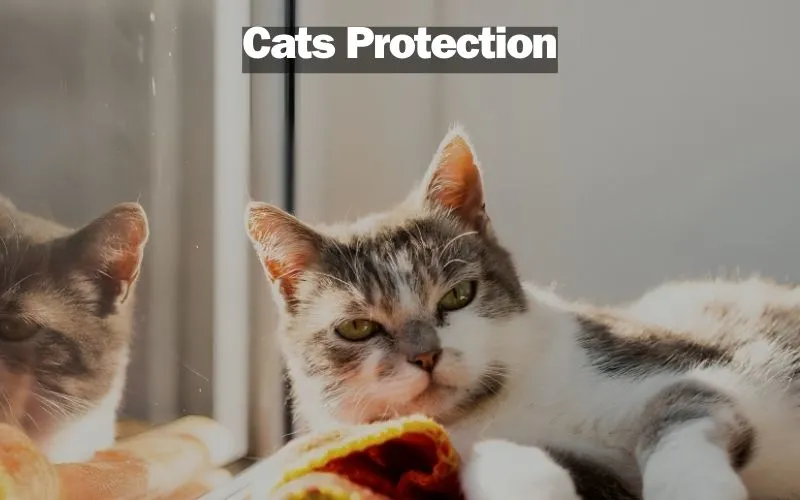Cats have been cherished companions to humans for thousands of years, providing comfort, joy, and an element of mystery to our lives. However, ensuring their well-being requires more than just affection. Proper care, understanding their needs, and addressing potential dangers are all vital components of responsible pet ownership. This article delves into various aspects of cats’ protection, aiming to inform and empower cat owners and enthusiasts to create a safe and nurturing environment for their feline friends.
Understanding Cats’ Basic Needs
Nutrition
Proper nutrition is fundamental to a cat’s health. Cats are obligate carnivores, meaning their diet must primarily consist of meat. High-quality commercial cat foods are formulated to provide the essential nutrients they need, including:
- Protein: Essential for growth and maintenance of body tissues. A diet lacking in protein can lead to muscle wasting and other health issues.
- Taurine: An amino acid crucial for heart and eye health. Deficiency can lead to blindness and heart failure.
- Fatty Acids: Important for healthy skin and coat. Omega-3 and Omega-6 fatty acids play a crucial role in reducing inflammation and supporting cognitive function.
- Vitamins and Minerals: Necessary for various bodily functions. Vitamin A, B vitamins, and minerals like calcium and phosphorus are vital for a cat’s overall health.
Avoid feeding cats dog food, human food, or raw meat as these can lead to nutritional imbalances or health issues. Additionally, avoid feeding cats onions, garlic, and chocolate, as these are toxic to them.
Hydration
Cats often do not drink enough water. Wet cat food can help maintain hydration, but always provide fresh, clean water. Some cats prefer running water, so consider a cat water fountain to encourage drinking. Dehydration can lead to serious health issues, such as urinary tract infections and kidney disease, so monitoring your cat’s water intake is crucial.
Shelter and Comfort
A comfortable living environment is crucial. Cats need:
- A Safe Space: A quiet area where they can retreat and feel secure. This could be a specific room or a cozy corner.
- Bedding: Soft, clean bedding in a warm place. Regularly wash the bedding to keep it free from dirt and parasites.
- Toys and Enrichment: To stimulate their minds and prevent boredom. Interactive toys, puzzle feeders, and regular playtime can keep your cat engaged and mentally stimulated.
Healthcare
Regular veterinary check-ups are essential. Vaccinations, flea and tick prevention, and regular deworming protect against common health issues. Dental care is also important; regular brushing and dental treats can help maintain oral health. Additionally, regular health screenings can detect early signs of chronic conditions such as diabetes, kidney disease, and hyperthyroidism, allowing for timely treatment.
Protecting Cats from Common Dangers
Indoor vs. Outdoor Living
While some cats enjoy the outdoors, it poses several risks such as traffic, predators, diseases, and toxic substances. Indoor cats generally live longer, healthier lives. However, if you choose to let your cat outside, take steps to minimize risks:
- Supervised Time: Keep an eye on them or use a leash and harness. This ensures they can explore safely.
- Safe Outdoor Enclosures: Catios (cat patios) or fenced areas can provide a safe outdoor experience. These structures protect cats from predators and prevent them from wandering into dangerous areas.
- Microchipping and Identification: Ensure your cat has a microchip and wears an ID tag with your contact information. This can help reunite you with your cat if they get lost.
Poisonous Plants and Substances
Many household plants and common substances are toxic to cats, including:
- Lilies: Extremely toxic, even small amounts can cause kidney failure.
- Poinsettias: Can cause vomiting and diarrhea.
- Chocolate, Caffeine, and Alcohol: Harmful to cats and should be kept out of reach.
- Household Chemicals: Cleaners, pesticides, and certain human medications can be dangerous if ingested.
Always check if plants and substances are safe for cats before bringing them into your home. Consider using cat-safe alternatives for household products and ensuring all hazardous items are stored securely.
Household Hazards
Keep the following potential hazards in mind:
- String and Small Objects: Can cause choking or intestinal blockages. Cats are often attracted to string, ribbons, and small toys that can be swallowed.
- Human Medications: Many are toxic to cats; store them securely. Common over-the-counter medications like acetaminophen and ibuprofen can be deadly to cats.
- Cleaning Products: Use cat-safe cleaning products and keep them away from curious paws. Even inhaling the fumes from some cleaners can be harmful to cats.
The Importance of Spaying and Neutering

Spaying (for females) and neutering (for males) are crucial for controlling the cat population and preventing unwanted litters. It also has health and behavioral benefits:
- Reduces the Risk of Diseases: Such as uterine infections and certain cancers. Spaying eliminates the risk of ovarian and uterine cancers, while neutering reduces the risk of prostate issues.
- Decreases Aggression: And territorial behaviors. Neutered males are less likely to spray urine to mark territory, and both sexes are generally calmer and less prone to fighting.
- Prevents Roaming: This reduces the risk of accidents and injuries. Cats that are not spayed or neutered are more likely to roam in search of mates, increasing their risk of getting lost or injured.
Consult your veterinarian about the appropriate age for these procedures. Early spaying and neutering, usually before six months of age, can be beneficial and prevent the onset of certain behaviors.
Addressing Behavioral Issues
Cats can exhibit a range of behaviors that might be problematic if not understood or managed correctly. Common issues include:
Scratching
Cats scratch to mark territory, sharpen claws, and stretch. Provide scratching posts and pads to protect furniture. Regularly trim their claws to reduce damage. Consider using claw caps or deterrent sprays if scratching becomes a significant problem.
Litter Box Problems
If a cat stops using the litter box, it could be due to medical issues, stress, or dissatisfaction with the litter box itself. Ensure the litter box is clean, placed in a quiet location, and that the litter type suits your cat’s preference. Multiple litter boxes are recommended for multi-cat households to prevent territorial disputes.
Aggression
Aggression can stem from fear, frustration, or territorial disputes. Identify triggers and consult a veterinarian or animal behaviorist if needed. Ensure your cat has enough space, stimulation, and attention. Behavioral modification techniques and, in some cases, medication may be necessary to manage aggression effectively.
Emotional Well-being for Cats Protection
Cats are social animals that require mental stimulation and companionship. Here are ways to support their emotional health:
Social Interaction
Spend quality time playing, grooming, and simply being with your cat. Some cats enjoy the company of other pets, but introductions should be gradual and supervised. Providing vertical space, like cat trees and shelves, can also help cats feel more secure and reduce territorial disputes.
Environmental Enrichment
Provide toys, climbing structures, and opportunities for hunting and exploring. Rotate toys to keep things interesting. Interactive play with wand toys and laser pointers can mimic hunting behavior and provide physical and mental exercise.
Routine and Stability
Cats thrive on routine. Regular feeding times, play sessions, and a stable environment help reduce stress. Sudden changes in the household, such as moving or new family members, can be stressful for cats. Gradual introductions and maintaining familiar routines can help ease transitions.
Adopting and Fostering Cats
Adopting or fostering a cat can be a rewarding experience. When considering bringing a cat into your home, evaluate your lifestyle, the cat’s personality, and any special needs they might have.
Adoption Benefits
- Saving Lives: Providing a home to a cat in need. Many cats in shelters are euthanized due to overcrowding.
- Supporting Shelters: Helps reduce overcrowding and support rescue efforts. Adoption fees often go towards medical care and support for other animals in the shelter.
- Variety of Choices: Shelters often have cats of all ages, breeds, and personalities. This allows you to find a cat that fits well with your lifestyle and preferences.
Fostering
Fostering provides temporary homes for cats awaiting permanent adoption. It’s a great way to help without a long-term commitment and can be particularly rewarding. Fosters help socialize cats, provide medical care, and prepare them for their forever homes. Many shelters provide support and supplies to foster families, making it easier to care for the cats.
Community and Legal Aspects for Cats Protection
Community Cat Programs
Trap-Neuter-Return (TNR) programs help manage feral cat populations humanely. TNR involves trapping feral cats, spaying/neutering them, and returning them to their territory. This reduces the number of kittens born in the wild and improves the health and longevity of feral cats. Community members can participate in TNR programs by volunteering to trap cats, provide recovery space, or donate to support the efforts.
Legal Considerations
Ensure you are aware of local laws regarding pet ownership, such as licensing, leash laws, and restrictions on the number of pets per household. Responsible pet ownership also means respecting neighbors and community spaces. Some communities have specific regulations for managing feral cat colonies, and being informed about these can help you contribute to humane and effective solutions.
Conclusion
Cats Protection involves a comprehensive approach that addresses their physical, emotional, and environmental needs. By understanding and meeting these needs, we can ensure our feline companions lead healthy, happy lives. Whether through providing proper nutrition, regular healthcare, or creating a safe living environment, every effort contributes to the well-being of cats. Additionally, community involvement and legal awareness further support the overall protection and care of these beloved animals.
Cats enrich our lives in countless ways. In return, they depend on us for their safety, health, and happiness. Through informed and responsible actions, we can ensure that cats continue to thrive as cherished members of our families and communities.




